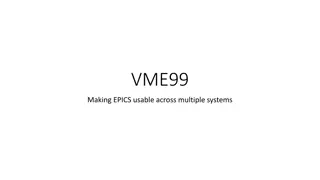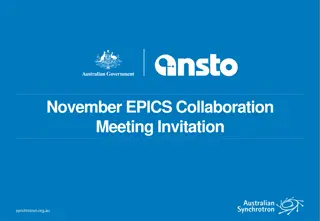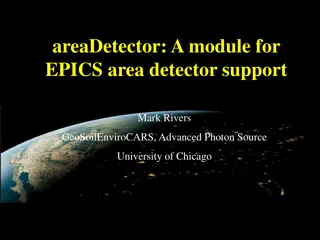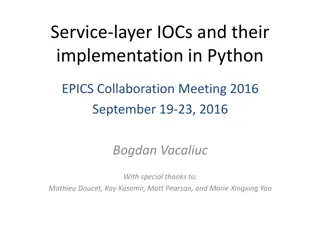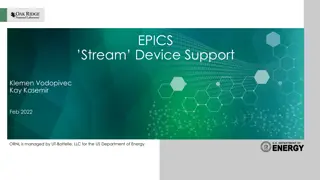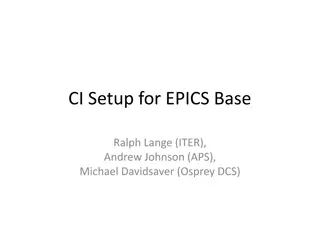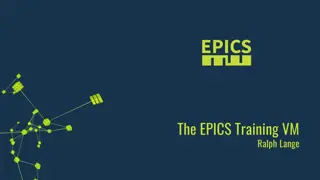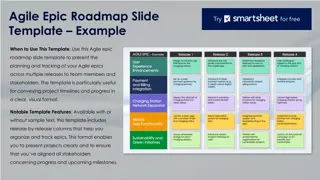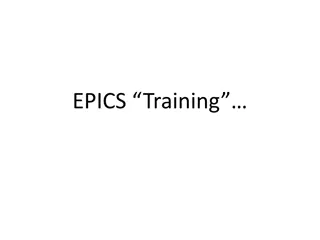
Innovative Approach to EPICS Control System Integration at ISIS Source Site
Explore the unique implementation of EPICS control system at ISIS Source Site involving PVAccess protocol, hardware interfaces, server deployment in container environment, user interfaces, and future preferences. Discover the advancements made since the last meeting and the progressive path towards EPICS adoption with Vsystem as a base.
Download Presentation

Please find below an Image/Link to download the presentation.
The content on the website is provided AS IS for your information and personal use only. It may not be sold, licensed, or shared on other websites without obtaining consent from the author. If you encounter any issues during the download, it is possible that the publisher has removed the file from their server.
You are allowed to download the files provided on this website for personal or commercial use, subject to the condition that they are used lawfully. All files are the property of their respective owners.
The content on the website is provided AS IS for your information and personal use only. It may not be sold, licensed, or shared on other websites without obtaining consent from the author.
E N D
Presentation Transcript
ISIS Source Site Report Ivan Finch Aqeel AlShafei, Kathryn Baker, Raunakk Banerjee, Gareth Howells, Ajit Kurup, Mateusz Leputa, Paul Ray, Mihnea Romanovschi EPICS Collaboration Meeting Spring 2025, Rutherford Appleton Laboratory Monday 7 April
A Brief Recap of Our EPICS Every site does EPICS differently. This is how ISIS Source is built: PVAccess protocol (not CA) Hardware Interfaces: Python / p4p for in-house developed, e.g. Moxa, MQTT, CIP "Conventional" IOCs developed by the EPICS community Vsystem through pvecho (bridge between control systems) Servers and services: Deployed into container environment (Docker Swarm) Using Phoebus middleware for archiving, save-and-restore, etc. User interfaces Using Phoebus and its infrastructure for HMIs and other user interfaces Exploring other web technologies, e.g. streamlet for ML
What we've done since the last Meeting Deployed our first "conventional" IOCs (community developed): Modbus FINS (~25% of our Vsystem channels) CPS / PXI in-house hardware using XML protocol (~50% of our Vsystem channels) Exploring OPC-UA as our preference for the future Developed a CI/CD pipeline to deploy our IOCs in containers On db change, only that container is restarted with new config On IOC change, all containers may be restarted PV Naming Convention Improved standard with feedback from equipment owners. Standardising of suffixes. Begun work on validator website, inspired by SNS example SnowSignal (UDP Broadcast Relay) fixed issues with IP fragmentation
Our Path to EPICS We started with and still use Vsystem, a "cousin" of EPICS. Built pvecho (v2e and e2v) to bridge between the two control systems: Built on-top of systems originally intended to monitor Vsystem for improved archiving MQTT, CouchDB (NoSQL database) Built using pvapy, many parts by analogy with Vsystem Our first "IOC" was an interface to Omron PLCs using the CIP protocol: Developed using p4p and existing Python code The PLC fully configures the PVs, including the PV name and alarm triggers We now have a complex control system! For example, our target steering reads thermocouples in EPICS, pvecho sends the data to Vsystem so that code written in Basic and running on OpenVMS can adjust steering magnets currents, and the new values are sent back to EPICS. There is no "conventional" IOC in this PID loop.
Development to Support Our Approach PV Naming: In Vsystem all channel names were guaranteed unique (centralised), in EPICS uniqueness must be enforced Developed tools for automated renaming of PVs across multiple systems (screens, alarms, S&R, etc.). Still problems with tracking changes to name. P4p for ISIS: We keep reinventing the wheel when using p4p, we decided to standardise. P4p supplies the structure of pva Normative Types but not their logic Need additional features, e.g. analogues of calc records and forward links RecCaster / pyRecCaster Mandate that all IOCs or equivalents must use RecCaster to report on existence of PVs, and IOCstats. In the case of p4p for this required the development of a new tool pyRecCaster. Expected enhancement to pvecho. Will allow us to identify, verify PV names, and automatically archive new PVs, etc. ChannelFinder Plan to use approach from other sites of automatically triggering archiving, etc. With PV Naming, role in automatically generating engineering screens
Problems with Our Approach & "conventional" IOCs Starting from Vsystem experience and pure Normative Types implementations to IOCs has exposed some assumptions that we made: We set long alarm messages (>20 characters) and channel descriptions. Up until Friday, alarm.message strings were displayed by Valarm unaltered via v2e PV length limits affect us during testing, as our previous method was to prefix DEV: PV, configuration from PLC (via MQTT) PV, from IOC RNG:WTR:EXTRACTSEPTUM1_PLC:DW4_LT01_LEVEL value double = 78.45 alarm.severity int32_t = 1 alarm.status int32_t = 4 alarm.message string = "ST12 Header Tank level DW4_LT01 Low Alarm" display.description string = "ST12 Header tank level(DW4_LT01)" valueAlarm.active bool = true valueAlarm.lowAlarmLimit double = 10 valueAlarm.lowWarningLimit double = 80 valueAlarm.highWarningLimit double = 100 valueAlarm.highAlarmLimit double = 150 valueAlarm.lowAlarmSeverity int64_t = 2 valueAlarm.lowWarningSeverity int64_t = 1 valueAlarm.highWarningSeverity int64_t = 1 valueAlarm.highAlarmSeverity int64_t = 2 hyst bool = true channelName string = "RNG:WTR:EXTRACTSEPTUM1_PLC:DW4_LT01_LEVEL" EPB1:MAG:ESEPTUM1:PSU:CURRENT struct "epics:nt/NTScalar:1.0" value double = 0 alarm.severity int32_t = 3 alarm.status int32_t = 2 alarm.message string = "COMM" valueAlarm.active bool = false valueAlarm.lowAlarmLimit double = nan valueAlarm.lowWarningLimit double = nan valueAlarm.highWarningLimit double = nan valueAlarm.highAlarmLimit double = nan valueAlarm.lowAlarmSeverity int32_t = 0 valueAlarm.lowWarningSeverity int32_t = 0 valueAlarm.highWarningSeverity int32_t = 0 valueAlarm.highAlarmSeverity int32_t = 0 valueAlarm.hysteresis int8_t = 0
Other work Vsystem to EPICS migration, supporting other institutions: Visit by PARTREC from the Netherlands radiation therapy research In contact with Helmholtz-Zentrum Berlin proton therapy Machine learning: Automated tuning of the LEBT, working towards deployment through Phoebus Virtual Injector PLP will extend this to the rest of the injector





